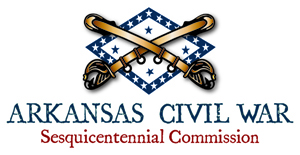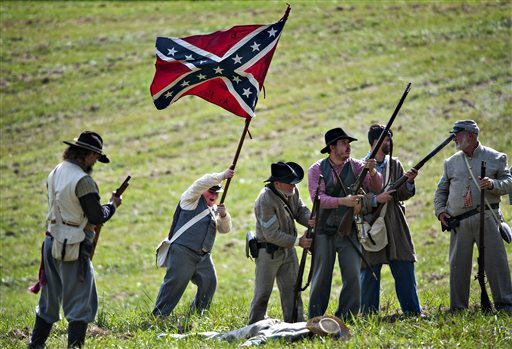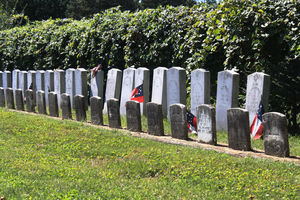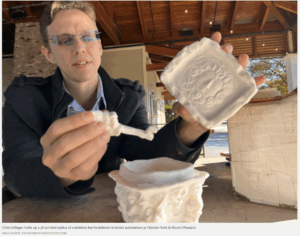MARYLAND: State Residents Weigh Removal of Confederate Statues
ANNAPOLIS — The Civil War divided many communities and families in Maryland, according to state historians, and mementos venerating forces for both the South and the North began to appear throughout the state in the early 1900s.
“(Soldiers) returned to Maryland without a great amount of animosity toward one another, and neither side cared if the other put up a monument to honor the dead,” said Daniel Carroll Toomey, a historian who has served on the state’s Military Monuments Commission for more than 20 years. “You can’t deny the fact that the South did go to war, but then they got over it — we got over it 150 years ago.”
Now, however, communities around the Old Line State are drawing upon old lines and asking officials to reconsider monuments tied to slavery or the Confederacy exactly four months after the racially motivated killings of nine people at a historic black church in Charleston, S.C.
In Baltimore, a special commission plans to meet Thursday night to reevaluate and lead community discussions about the city’s nine Confederate monuments, continuing the national conversation about the display of racially controversial memorials, flags and other insignia.
The first of four meetings, commissioned by Mayor Stephanie Rawlings-Blake, could determine how the city will memorialize the state’s Confederate past.
In spite of some of the communities’ or council members’ objections to the monuments, Toomey said, he believes the monument evaluation committee in Baltimore City is unnecessary.
“The monuments are not just the history of Baltimore City, they are just not the history of Maryland, they’re American history,” Toomey said. “And no one, no mayor has the right to say what part of American history will be remembered and what will be forgotten.”
According to Howard Libit, a spokesman for the mayor, the commission is seeking to review all Confederate-era monuments and historical items “to ensure that the city stays on the side of respecting history.”
“There is a balance between respecting history and continuing to display items that may be offensive,” Libit said.
Though Rawlings-Blake’s announcement did not name any of the statues that the commission will review, there are at least nine monuments with ties to the Confederate era in the city, according to a 2014 Maryland Department of Veterans Affairs monuments catalog.
At least one of the statues honoring Confederate soldiers in the city’s Bolton Hill neighborhood was spray-painted with the phrase “Black Lives Matter” five days after the June 17 Charleston shooting.
Costs of cleaning the statues following vandalism, or completely removing the statues altogether, have not been discussed, according to Aaron Bryant, chairman of the seven-member commission and the current Mellon curator of photography at the Smithsonian’s National Museum of African American History and Culture.
But Montgomery County has already spent $20,000 boxing up and cleaning a Confederate statue that was similarly vandalized.
And the Montgomery County Council also plans to meet Thursday night to decide where to relocate the 102-year-old bronze statue of a Confederate soldier standing next to Rockville’s Red Brick Courthouse. The memorial also had the words “Black Lives Matter” spray-painted on its base, in July.
“We need to find out if we will get approval to relocate the statue” and then the county will get estimates to pay for moving it, said Greg Ossont, deputy director of the Department of General Services.
In an effort to determine a new, more appropriate location, Montgomery County residents voted earlier this month on a list of five new locations for the statue. The list included: Beall-Dawson Historical Park in Rockville, Darnestown Square Heritage Park in Darnestown, Callithea Farm Special Park in Potomac, Jesup Blair Local Park in Silver Spring and Edgehill Farm in Gaithersburg. Poll results are expected to be discussed on Thursday.
“We share County Executive Isiah Leggett’s view that the statue does not belong in the center of government outside the courthouse,” said County Council President George Leventhal in a news release. “(We) believe it should be relocated to a site where we are able to tell the full story of Montgomery County’s participation in the Civil War from all perspectives.”
North of Rockville, at the Monocacy National Battlefield, there is another Confederate monument, which the United Daughters of the Confederacy funded and built in 1914.
“We haven’t had any issues with our monuments and no indication of defacement or other tampering,” said Rick Slade, superintendent at Monocacy National Battlefield. “It’s a simple roadside rock pedestal with a plaque. It’s not very elaborate or distinctive, so it doesn’t attract a lot of attention.”
At the seat of the county, however, Frederick city’s Board of Aldermen are deliberating whether to remove the bust of former U.S. Supreme Court Chief Justice Roger B. Taney from in front of City Hall.
Taney’s opinion in the Dred Scott v. Sandford case protected slaveholders’ rights and excluded African Americans from citizenship.
“Although Justice Taney was a complex individual, he is most widely known for writing the majority opinion on the case of Dred Scott v. Sandford — a legal opinion that set the rights of all blacks back decades,” Alderwoman Donna Kuzemchak, a Democrat, wrote in an email.
In 2008, Frederick officials compromised with Taney opponents and added a plaque to the bust stating that the Dred Scott decision “revealed the content of established racism in our law and in our thinking.”
Frederick Mayor Randy McClement stated the fabrication, design and installation of the plaque cost the city $20,000 and estimated that moving the bust could cost around $10,000, according to McClement’s press secretary.
In her third attempt to remove the bust, Kuzemchak wrote, she will propose her resolution at a public meeting Oct. 1.
“I have no desire to remove all Confederate statues and memorials,” she wrote. “Pretending something never happened is not the answer. However, honoring a man who is best known for words that dehumanized an entire race is something I cannot abide.”
Despite the city’s efforts to remove the statue, there remain other tributes honoring Taney around the city including Taney Avenue, his grave and his house, which is a historical landmark.
This is where the mess of drawing a distinction begins, Toomey said, like which Confederate-oriented statues should and should not be removed. Though he agrees with the decision to not fly the Confederate flag over government buildings, Toomey said, the monuments should remain in place.
“If anyone was a slaveowner … you would have to take down the Washington Monument, the Jefferson Memorial and blow a path through Mount Rushmore or change the name of the capital,” Toomey said. “Where does it stop?”
Other counties, including Talbot County, are reconsidering statues and memorials in public places. Corey Pack, Talbot County’s council president, said officials will discuss the Confederate-honoring, privately funded ‘Talbot Boys’ statue in front of Easton’s courthouse next week at a meeting.
One option includes adding a second statue to the lawn, to honor the Union soldiers from the county, Pack said.
“We are going to talk about what the next step looks like and what the next step should be,” Pack said. “We are moving and we are trying not to be stagnant during this time.”
–stardem.com
###
ARKANSAS: Civil War 150th Anniversary Marker Approved
LITTLE ROCK—The Arkansas Civil War Sesquicentennial Commission has approved an application for an Arkansas Civil War Sesquicentennial Historical Marker in Sharp County, ACWSC Chairman Tom Dupree announced today.
 The approved marker is sponsored by the Sharp County Historical Society and will commemorate Unionist Ephraim Sharp and the Civil War in Sharp County. It will be located on the corner of West Main and Court streets in Evening Shade.
The approved marker is sponsored by the Sharp County Historical Society and will commemorate Unionist Ephraim Sharp and the Civil War in Sharp County. It will be located on the corner of West Main and Court streets in Evening Shade.
Through the Arkansas Civil War Sesquicentennial Historical Marker Program, the ACWSC works with local partners to help tell the stories of how the Civil War affected communities around the state. The Commission hopes that there will be at least one marker in each of the state’s 75 counties by the end of the commemoration in 2015. Counties that currently do not have Arkansas Civil War Sesquicentennial Historical Markers are Howard and Polk.
To date, 134 markers in 73 counties have been approved. Marker applications are available at http://www.arkansascivilwar150.com/historical-markers/markers.aspx.
For more information on sesquicentennial plans, visit www.arkansascivilwar150.com or [email protected].
The Arkansas Civil War Sesquicentennial Commission is housed within the Arkansas Historic Preservation Program. The AHPP is the Department of Arkansas Heritage agency responsible for identifying, evaluating, registering and preserving the state’s cultural resources. Other agencies are the Arkansas Arts Council, the Delta Cultural Center in Helena, the Old State House Museum, the Mosaic Templars Cultural Center, the Arkansas Natural Heritage Commission and the Historic Arkansas Museum.
–arkansaspreservation.com
###
VIRGINIA: Confederate Flag rally Continues Outside Christianburg High School
About a dozen people were seen standing in the rain Monday morning, holding flags and cheering at cars as they drove by.
Friday, the Rebelution and Battle Flag Rally for Freedom groups announced they would be rallying outside the school.
This comes after a new policy banning the flag outside in the school parking lots.
–virginiafirst.com
###
KENTUCKY: Civil War Days Brought To Life
MUNFORDVILLE, KY. — For the last 20 years, Civil War re-enactor Mike Beck has been stepping back in time and into the shoes of his great-great-grandfather who fought for the Union from 1861 to 1865.

In this Sept. 12, 2015, photo Daniel Bowman, 12, waves a Confederate flag as he stand with his regiment during the Hart County Civil War Days historical re-enactment of the Battle of Munfordville in Munfordville, Ky. (Miranda Pederson/Daily News via AP)
Beck, who is a member of Company D 11th Indiana Volunteer Zouaves, fought alongside his friends on Sept. 12 during the Hart County Civil War Days re-enactment of the Battle for the Bridge on the 219-acre Munfordville Battlefield, the site of three Civil War battles, including the September 1862 Battle and Siege of Munfordville.
Beck’s great-great-grandfather served in the 15th Ohio Volunteer Infantry and actually camped on the Munfordville Battlefield during a cold winter on his way south during the Civil War. He was captured at the Battle of Stones River in Murfreesboro and held as a prisoner of war at Libby Prison and later released.
To honor his family heritage, Beck dons the blues and heads out to re-enactments.
“It’s to honor my great-great-grandfather, and I’m a history buff,” he said. “It’s relaxing for me. We’ve got a great group of guys from all over Indiana, all different occupations.”
Beck is a lieutenant at the Indiana Law Enforcement Academy.
“I want to give more of a history lesson than the kids are getting at school and we do that,” he said after coming off the battlefield recently.
Beck participates in multiple re-enactments every year.
Police Officer Charles Minard of Gary, Ind., is also a member of an Indiana volunteer regiment and doesn’t want the country’s history lost.
“With us doing what we do, we feel we can keep the history alive for all the people who fought and died here,” Minard said.
This is Minard’s fourth year in Civil War re-enacting.
Both men were camping at the site this weekend in period tents and living as the soldiers did during that time period.
Behind them, Robert Smith of Elizabethtown was encamped with his wife Carolyn. He is the Confederate commander of the Sixth Kentucky Regiment Company D.
“I originally started doing this because I liked history,” Smith said, “I found out that my third great-uncle fought and died for the Sixth Kentucky Regiment Company B.”
Smith’s uncle fought throughout the South and died after being wounded in the Battle of Shiloh. He died en route on a hospital train to Nashville when he succumbed to his battle wounds and was buried in a plot overlooking the Tennessee River.
“I think it’s important (to re-enact) because it teaches people history. It’s not the history they teach in the history books.”
Ethan Miller, 14, of Scottsville, is a member of Smith’s regiment.
“I always loved history,” Miller said. “I looked up my family history. I have a great-great-great-grandfather who fought with the 48th Infantry.”
He was a Confederate captain. So Miller decided to step into his boots.
“Where else can you go and shoot at your friends all weekend and everybody comes home happy?” Smith said.



